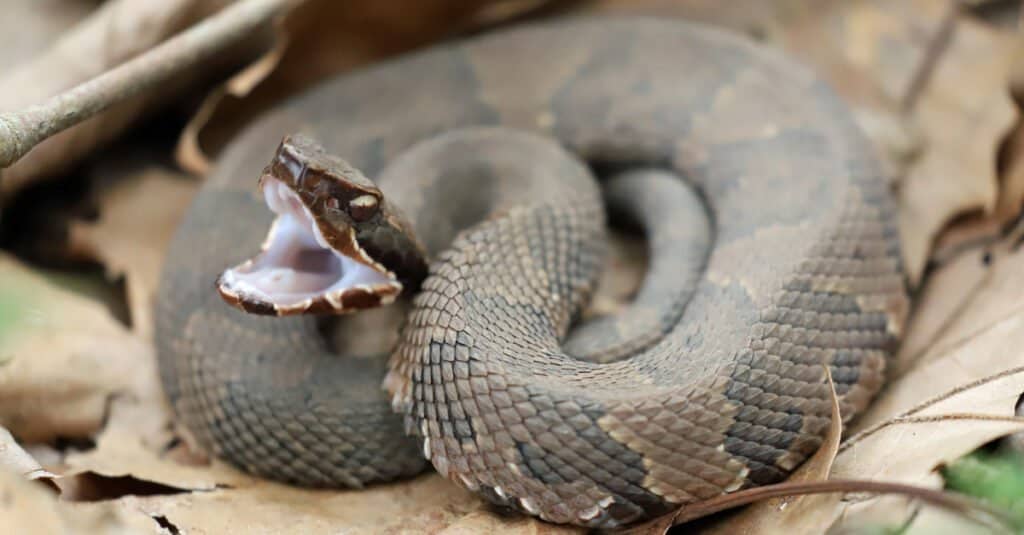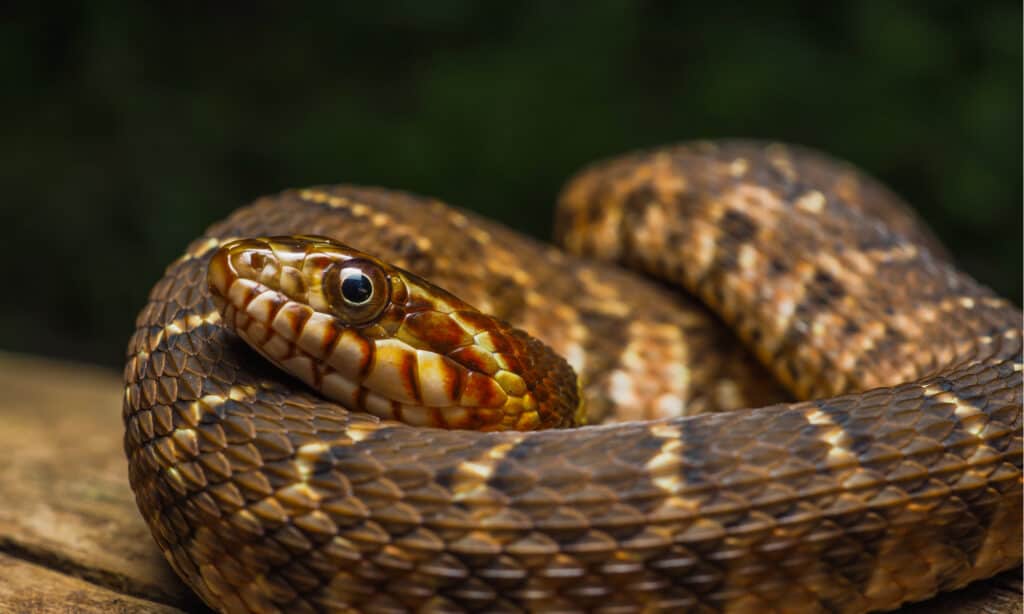In the southeastern United States, there are two species of snake that are commonly mistaken for one another. These are the cottonmouth, also known as the water moccasin, and the yellow-bellied watersnake, also known as the plain-belly watersnake. Each species has distinct characteristics marking it apart from the other, yet they’re often confused with one another and, unfortunately, killed by snake-fearing humans. No matter which species you’re looking at, both are important parts of their native ecosystems, and should not be killed unless absolutely necessary.
The yellow-bellied watersnake (Nerodia erythrogaster) occupies many of the same habitats as the water moccasin (Agkistrodon piscivorus), yet the two behave in very different ways. They also hunt different creatures, and only one of them has a mouth complete with two long, hollow fangs capable of delivering dangerous venom.
Here, we’ll learn all about the differences and similarities between cottonmouths and yellowbelly watersnakes, starting with their looks. Then, we’ll compare their habitats, behaviors, and unique diets. Finally, we’ll take a look at which species is more dangerous, and what you should do if bitten by either type of snake.
The Key Difference Between a Yellow-Bellied Watersnake and Cottonmouth

The key difference between cottonmouths and yellow-bellied water snakes is that cottonmouths are venomous. In addition, the two have very different appearances. Yellow-bellied water snakes are true to their name, and lack the distinctive banding of cottonmouths. Yellow-bellied water snakes are also more likely to flee if a human startles them. Let’s dive into their main differences one by one.
Yellow-Bellied Watersnake Vs Cottonmouth: Appearance
Beginning with their looks, both the yellow-bellied watersnake and cottonmouth have medium to large, heavy bodies. Water moccasins grow a little bigger, up to five feet on average, while yellowbellies generally top out around four feet. Both species have thick bodies, but cottonmouths have bigger heads. Further, cottonmouths are pit vipers, with heat-sensing pits located just behind their nostrils. Yellowbellies, on the other hand, cannot sense heat, and lack pits.
Still looking at the head, one of the biggest differences between the two species is the shape of the pupil; cottonmouths have an elliptical pupil, while yellow-bellied watersnakes have round pupils. But perhaps the most obvious difference between the two lies in the adult coloring. As their name suggests, yellowbellies have yellow to white undersides with solid gray to black bodies. Water moccasins, on the other hand, range from yellow-brown to brown-black, and have distinct darker bands encircling their bodies.
For both species, young snakes have lighter coloring and more obvious markings. This is especially apparent in yellow-bellied watersnakes. Juvenile yellowbellies are pale gray-orange with dark brown splotches.
Yellow-Bellied Watersnake Vs Cottonmouth: Habitat
Regionally, water moccasins and yellow-bellied watersnakes can be found in all the same places. They’re common throughout Florida and the southeastern United States as far north as Virginia and as far west as eastern Texas. Both species prefer lowlands, and neither occurs too far from freshwater.
Being semi-aquatic snakes, both cottonmouths and yellowbellies live, and hunt, near sources of water like ponds, streams, marshes, lakes, and wetlands. Yellow-bellied watersnakes shy away from fast-moving water, and are more likely to be found near sources of slow-moving or even stagnant water. Both species bask in the sun near the water’s edge or drape their bodies over branches overhanging the water.
Yellow-Bellied Watersnake Vs Cottonmouth: Behavior
Both cottonmouths and yellowbellies are ovoviviparous species. This means that, rather than laying eggs, the babies stay inside, all separated by thin membranes, and develop within the females. Then, they give birth to live young. Cottonmouths have between 1-20 young per birth, while yellow-bellied watersnakes can have up to 55 snakelings at once. The larger the female yellowbelly, the more young she produces.

Cottonmouths have elliptical eyes and patterned markings on their bodies
©KF2017/Shutterstock.com
When threatened, yellow-bellied watersnakes are more likely to flee than cottonmouths. Cottonmouths will coil up and stand their ground by displaying the white insides of their mouths. Yellowbellies, if cornered, will not hesitate to bite, and even produce foul-smelling musk which they rub on attackers.
Yellow-Bellied Watersnake Vs Cottonmouth: Diet
Of the two species, cottonmouths have the more varied diet. They’re big snakes, and they have potent venom, which means they can eat anything they can fit into their mouths. This includes fish, turtles, birds, rodents, amphibians, and even baby alligators. Yellow-bellied watersnakes hunt almost entirely in the water or along the water’s edge; they eat crayfish, fish, salamanders, frogs, and toads. Both species have been observed waiting in ambush as well as actively seeking out prey.
Yellow-Bellied Watersnake Vs Cottonmouth: Venom
While both snakes appear fearsome, only one has venom glands. Cottonmouths are members of the pit viper family, and along with their heat-sensing capabilities, they also have hollow, venom-delivering fangs. Like rattlesnakes and copperheads, water moccasins have hemotoxic venom designed to incapacitate and kill small animals. The venom is also necrotizing, meaning that, from the moment of injection, it starts working to digest the surrounding tissue.

Yellow-bellied watersnakes are far less dangerous than cottonmouths.
©Tyler Albertson/Shutterstock.com
Yellow-bellies, however, have no venom. They’re considered harmless by snake standards, though you don’t want to pet them. Yellow-bellied watersnakes react violently when threatened, and may bite a person multiple times if needed.
Yellow-Bellied Watersnake Vs Cottonmouth: Which is More Dangerous?
Out of the two species, only one poses a risk to human life, and that’s the cottonmouth. Cottonmouth venom can cause serious complications and even death if left untreated. In the case of a bite, you should immediately move away from the snake to avoid further injury. Do not try to ice the bite, or suck out the venom. Additionally, don’t make any kind of cuts into the skin near the punctures. Instead, get to a hospital as quickly as you can.
Water moccasin bites are very rarely fatal, but risks of complications go up exponentially if the bite is left untreated. At the hospital, medical professionals will monitor the injury for signs of envenomation; not all bites actually deliver venom. Often, when venom is injected, the area around the bite swells, and the tissue may even blacken and slough off. It’s because of their venom that cottonmouths are unquestionably more dangerous than yellow-bellied watersnakes.
The photo featured at the top of this post is © Tyler Albertson/Shutterstock.com
Discover the "Monster" Snake 5X Bigger than an Anaconda
Every day A-Z Animals sends out some of the most incredible facts in the world from our free newsletter. Want to discover the 10 most beautiful snakes in the world, a "snake island" where you're never more than 3 feet from danger, or a "monster" snake 5X larger than an anaconda? Then sign up right now and you'll start receiving our daily newsletter absolutely free.
Thank you for reading! Have some feedback for us? Contact the AZ Animals editorial team.






